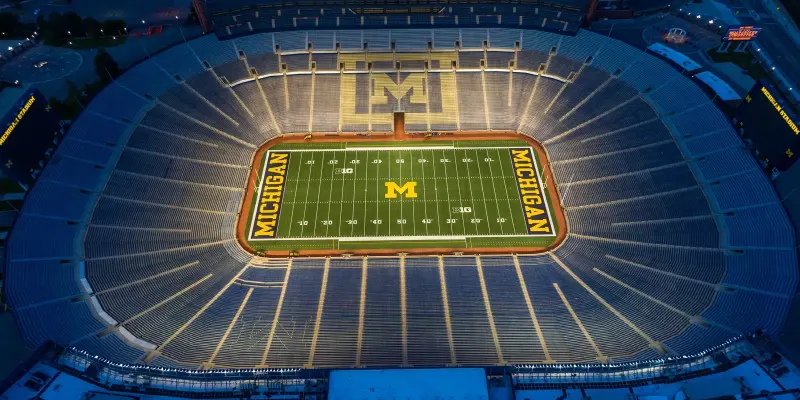
Michigan Stadium: Iconic History & Capacity
Nicknamed “The Big House,” Michigan Stadium is more than just a football field—it’s a legendary landmark in American sports. With its massive capacity and deep-rooted history, it stands as a proud symbol of the University of Michigan. For any fan wanting to truly grasp the essence of college football, experiencing the energy here is a must. From unforgettable rivalries to thrilling kèo nhà cái odds that shape every game day, The Big House is where tradition meets intensity.
History of Michigan Stadium
To truly appreciate Michigan Stadium, one must first delve into its storied past.
The history of Michigan Stadium begins in the early 1920s when the university recognized a need for a larger facility to accommodate its growing football fan base. Before its construction, the team played in smaller venues, and as the team’s popularity surged, so did the demand for a proper stadium.
The stadium was inaugurated in 1927, with an original seating capacity of around 72,000. It’s noteworthy that Michigan Stadium was one of the first college football stadiums to be modeled after a large-scale professional venue, which further contributed to its heritage.
Evolution Through the Years
Over the decades, Michigan Stadium has undergone numerous renovations to keep pace with the evolving demands of fans and advancements in stadium design.
The most significant renovation came in the 1990s when the seating capacity was expanded to accommodate over 107,000 fans. This expansion transformed the stadium into the largest in the United States and one of the largest in the world.
Moreover, the investments made in upgrading facilities, including updated suites and improved concession options, reflect an ongoing commitment to enhancing the game-day experience while preserving the historical essence of the monumental structure.
Moments That Shaped Its History
Several pivotal moments have defined Michigan Stadium‘s historical narrative.
From George Gipp’s legendary performance in the 1920s to Barry Sanders’ Heisman Trophy-winning season, the stadium has been the stage for unforgettable moments that will forever echo in college football lore.
Perhaps one of the most significant games was the thrilling 1979 clash between Michigan and Ohio State, where both teams were ranked in the top five and the rivalry reached new heights. Games like these have contributed to the mythos surrounding the stadium, creating an aura that is palpable when one walks through its gates.
Capacity and Design of Michigan Stadium
Michigan Stadium’s monumental capacity and design make it an architectural marvel within the pantheon of stadiums.
At its heart, the design of Michigan Stadium is a blend of functionality and tradition. When you step into the stadium, the sheer size and structure resonate with the energy of the thousands who gather to witness college football at its finest.
Capacity Details
The stadium remains the largest in the United States, with a seating capacity exceeding 107,000.
This impressive capacity is a magnet for not only avid college football fans but also for tourists and sports enthusiasts worldwide, drawing them to Ann Arbor for the vibrant game day atmosphere.
Moreover, the configuration of the seats ensures that even in the highest sections, fans can enjoy a clear view of the field, emphasizing the stadium’s focus on enhancing the spectator experience.
Architectural Highlights
The architectural design of Michigan Stadium is a testament to its historical roots, combined with modern upgrades.
Constructed predominantly with brick and adorned with stately arches, the stadium retains a classic appearance consistent with its heritage. The wide concourses and upgraded seating areas reflect the evolution of fan expectations, merging efficiency with aesthetic appeal.
The square footage of the venue is immense, allowing for spacious walkways and fan zones that prevent congestion, making game day an enjoyable experience even amidst throngs of attendees.
Unique Features
One particularly notable feature of Michigan Stadium is the “Big House” moniker itself.
The name is a nod to its vastness, but it also embodies the community atmosphere found within its walls. Amenities, such as the state-of-the-art scoreboard and upgraded medical facilities, enhance not just the game experience but also player safety and comfort.
Another aspect of Michigan Stadium that stands out is the way it has adjusted to modern-day technology needs, integrating upgraded sound systems, in-stadium Wi-Fi, and mobile app services, allowing fans to engage more deeply with their event experiences.
Memorable Moments at Michigan Stadium
When one thinks of Michigan Stadium, it’s impossible not to conjure up images of the countless memorable moments that have unfolded on its field.
Each game day is not just a date on a calendar but a chance to celebrate the history and tradition that Michigan Stadium embodies.
Iconic Games
Some of the most iconic games in college football history have taken place at Michigan Stadium.
From the heart-stopping clashes with rival teams like Ohio State and Notre Dame to the stunning victories that shaped seasons and careers, the stadium has witnessed it all. Each game tells a story not just for the players but also for the fans in attendance.
For instance, the 2005 showdown against Michigan State saw Michigan trailing and mounting an incredible late-game rally, a nail-biter that still reverberates in the memories of those who were present.
Unforgettable Players
Many legendary players have graced the hallowed field of Michigan Stadium.
Names like Tom Harmon, Desmond Howard, and Charles Woodson are not just spoken with reverence in Ann Arbor but have left indelible marks on college football history.
The legacy left by these players contributes to the emotional fabric that envelops the stadium, ensuring that fans feel connected not just to the team but to the broader history of collegiate athletics.
Special Events
In addition to regular-season games, Michigan Stadium has hosted several special events that have added to its storied history.
From the Big Chill, a hockey game played outside at the stadium, showcasing Michigan’s frost-friendly sports culture, to concerts featuring renowned artists, the stadium has established itself as a versatile venue rather than simply a football-centric space.
Such events reiterate the emotional and cultural significance of Michigan Stadium, extending beyond the gridiron to become a meeting place for a celebration of athleticism, music, and community spirit.



